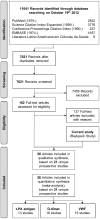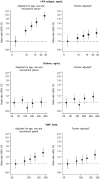Hemostatic factors and risk of coronary heart disease in general populations: new prospective study and updated meta-analyses
- PMID: 23408959
- PMCID: PMC3567058
- DOI: 10.1371/journal.pone.0055175
Hemostatic factors and risk of coronary heart disease in general populations: new prospective study and updated meta-analyses
Abstract
Background: Activation of blood coagulation and fibrinolysis may be associated with increased risk of coronary heart disease. We aimed to assess associations of circulating tissue plasminogen activator (t-PA) antigen, D-dimer and von Willebrand factor (VWF) with coronary heart disease risk.
Design: Prospective case-control study, systematic review and meta-analyses.
Methods: Measurements were made in 1925 people who had a first-ever nonfatal myocardial infarction or died of coronary heart disease during follow-up (median 19.4 years) and in 3616 controls nested within the prospective population-based Reykjavik Study.
Results: Age and sex-adjusted odds ratios for coronary heart disease per 1 standard deviation higher baseline level were 1.25 (1.18, 1.33) for t-PA antigen, 1.01 (0.95, 1.07) for D-dimer and 1.11 (1.05, 1.18) for VWF. After additional adjustment for conventional cardiovascular risk factors, corresponding odds ratios were 1.07 (0.99, 1.14) for t-PA antigen, 1.06 (1.00, 1.13) for D-dimer and 1.08 (1.02, 1.15) for VWF. When combined with the results from previous prospective studies in a random-effects meta-analysis, overall adjusted odds ratios were 1.13 (1.06, 1.21) for t-PA antigen (13 studies, 5494 cases), 1.23 (1.16, 1.32) with D-dimer (18 studies, 6799 cases) and 1.16 (1.10, 1.22) with VWF (15 studies, 6556 cases).
Conclusions: Concentrations of t-PA antigen, D-dimer and VWF may be more modestly associated with first-ever CHD events than previously reported. More detailed analysis is required to clarify whether these markers are causal risk factors or simply correlates of coronary heart disease.
Conflict of interest statement
Figures




Similar articles
-
Long-term interleukin-6 levels and subsequent risk of coronary heart disease: two new prospective studies and a systematic review.PLoS Med. 2008 Apr 8;5(4):e78. doi: 10.1371/journal.pmed.0050078. PLoS Med. 2008. PMID: 18399716 Free PMC article.
-
Exercise-based cardiac rehabilitation for coronary heart disease.Cochrane Database Syst Rev. 2021 Nov 6;11(11):CD001800. doi: 10.1002/14651858.CD001800.pub4. Cochrane Database Syst Rev. 2021. PMID: 34741536 Free PMC article.
-
Effects of a gluten-reduced or gluten-free diet for the primary prevention of cardiovascular disease.Cochrane Database Syst Rev. 2022 Feb 24;2(2):CD013556. doi: 10.1002/14651858.CD013556.pub2. Cochrane Database Syst Rev. 2022. PMID: 35199850 Free PMC article.
-
Renal function and risk of coronary heart disease in general populations: new prospective study and systematic review.PLoS Med. 2007 Sep;4(9):e270. doi: 10.1371/journal.pmed.0040270. PLoS Med. 2007. PMID: 17803353 Free PMC article.
-
Smoking cessation for secondary prevention of cardiovascular disease.Cochrane Database Syst Rev. 2022 Aug 8;8(8):CD014936. doi: 10.1002/14651858.CD014936.pub2. Cochrane Database Syst Rev. 2022. PMID: 35938889 Free PMC article.
Cited by
-
Diagnostic Utility of a Combined MPO/D-Dimer Score to Distinguish Abdominal Aortic Aneurysm from Peripheral Artery Disease.J Clin Med. 2023 Dec 7;12(24):7558. doi: 10.3390/jcm12247558. J Clin Med. 2023. PMID: 38137627 Free PMC article.
-
Shear Stress-Induced Activation of von Willebrand Factor and Cardiovascular Pathology.Int J Mol Sci. 2020 Oct 21;21(20):7804. doi: 10.3390/ijms21207804. Int J Mol Sci. 2020. PMID: 33096906 Free PMC article. Review.
-
Histone deacetylase inhibition enhances tissue plasminogen activator release capacity in atherosclerotic man.PLoS One. 2015 Mar 25;10(3):e0121196. doi: 10.1371/journal.pone.0121196. eCollection 2015. PLoS One. 2015. PMID: 25807501 Free PMC article.
-
The in vitro effects of sodium salicylate on von Willebrand factor and C-reactive protein production by endothelial cells.Inflammopharmacology. 2014 Dec;22(6):367-72. doi: 10.1007/s10787-014-0212-1. Epub 2014 Jul 24. Inflammopharmacology. 2014. PMID: 25055995
-
Significant decrease of von Willebrand factor and plasminogen activator inhibitor-1 by providing supplementation with selenium and coenzyme Q10 to an elderly population with a low selenium status.Eur J Nutr. 2020 Dec;59(8):3581-3590. doi: 10.1007/s00394-020-02193-5. Epub 2020 Feb 20. Eur J Nutr. 2020. PMID: 32078064 Free PMC article.
References
-
- Borissoff JI, Spronk HMH, ten Cate H (2011) The hemostatic system as a modulator of atherosclerosis. N Engl J Med 364: 1746–1760. - PubMed
-
- Lowe GDO (2006) Can haematological tests predict cardiovascular risk? The 2005 Kettle Lecture. Br J Haematol 133: 232–250. - PubMed
-
- Plow EF, Felez J, Miles LA (1991) Cellular regulation of fibrinolysis. Thromb Haemost 66: 32–36. - PubMed
-
- Nordenhem A, Wiman B (1998) Tissue plasminogen activator (tPA) antigen in plasma: correlation with different tPA/inhibitor complexes. Scand J Clin Lab Invest 58: 475–483. - PubMed
-
- Lip GY, Lowe GD (1995) Fibrin D-dimer: a useful clinical marker of thrombogenesis? Clin Sci (Lond) 89: 205–214. - PubMed
Publication types
MeSH terms
Substances
Grants and funding
LinkOut - more resources
Full Text Sources
Other Literature Sources
Miscellaneous

